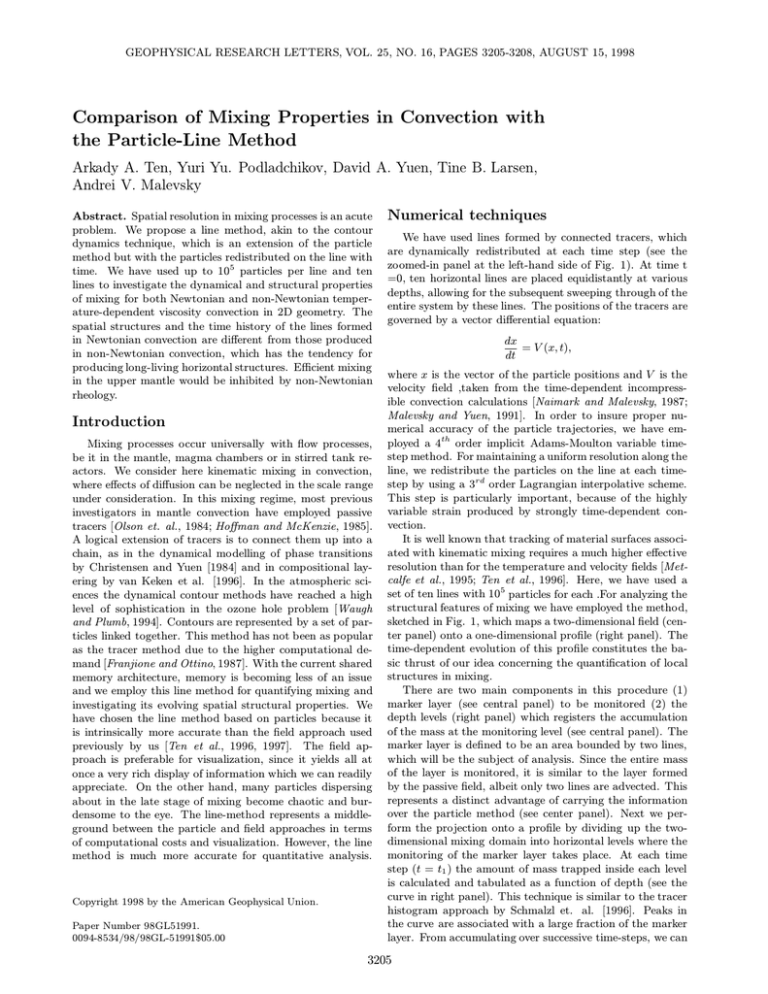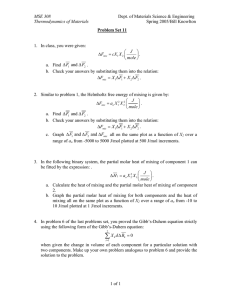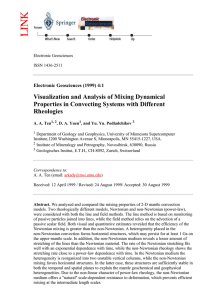Comparison of Mixing Properties in Convection with the Particle-Line Method
advertisement

GEOPHYSICAL RESEARCH LETTERS, VOL. 25, NO. 16, PAGES 3205-3208, AUGUST 15, 1998 Comparison of Mixing Properties in Convection with the Particle-Line Method Arkady A. Ten, Yuri Yu. Podladchikov, David A. Yuen, Tine B. Larsen, Andrei V. Malevsky Abstract. Spatial resolution in mixing processes is an acute problem. We propose a line method, akin to the contour dynamics technique, which is an extension of the particle method but with the particles redistributed on the line with time. We have used up to 105 particles per line and ten lines to investigate the dynamical and structural properties of mixing for both Newtonian and non-Newtonian temperature-dependent viscosity convection in 2D geometry. The spatial structures and the time history of the lines formed in Newtonian convection are different from those produced in non-Newtonian convection, which has the tendency for producing long-living horizontal structures. Efficient mixing in the upper mantle would be inhibited by non-Newtonian rheology. Introduction Mixing processes occur universally with flow processes, be it in the mantle, magma chambers or in stirred tank reactors. We consider here kinematic mixing in convection, where effects of diffusion can be neglected in the scale range under consideration. In this mixing regime, most previous investigators in mantle convection have employed passive tracers [Olson et. al., 1984; Hoffman and McKenzie, 1985]. A logical extension of tracers is to connect them up into a chain, as in the dynamical modelling of phase transitions by Christensen and Yuen [1984] and in compositional layering by van Keken et al. [1996]. In the atmospheric sciences the dynamical contour methods have reached a high level of sophistication in the ozone hole problem [Waugh and Plumb, 1994]. Contours are represented by a set of particles linked together. This method has not been as popular as the tracer method due to the higher computational demand [Franjione and Ottino, 1987]. With the current shared memory architecture, memory is becoming less of an issue and we employ this line method for quantifying mixing and investigating its evolving spatial structural properties. We have chosen the line method based on particles because it is intrinsically more accurate than the field approach used previously by us [Ten et al., 1996, 1997]. The field approach is preferable for visualization, since it yields all at once a very rich display of information which we can readily appreciate. On the other hand, many particles dispersing about in the late stage of mixing become chaotic and burdensome to the eye. The line-method represents a middleground between the particle and field approaches in terms of computational costs and visualization. However, the line method is much more accurate for quantitative analysis. Copyright 1998 by the American Geophysical Union. Paper Number 98GL51991. 0094-8534/98/98GL-51991$05.00 Numerical techniques We have used lines formed by connected tracers, which are dynamically redistributed at each time step (see the zoomed-in panel at the left-hand side of Fig. 1). At time t =0, ten horizontal lines are placed equidistantly at various depths, allowing for the subsequent sweeping through of the entire system by these lines. The positions of the tracers are governed by a vector differential equation: dx = V (x, t), dt where x is the vector of the particle positions and V is the velocity field ,taken from the time-dependent incompressible convection calculations [Naimark and Malevsky, 1987; Malevsky and Yuen, 1991]. In order to insure proper numerical accuracy of the particle trajectories, we have employed a 4th order implicit Adams-Moulton variable timestep method. For maintaining a uniform resolution along the line, we redistribute the particles on the line at each timestep by using a 3rd order Lagrangian interpolative scheme. This step is particularly important, because of the highly variable strain produced by strongly time-dependent convection. It is well known that tracking of material surfaces associated with kinematic mixing requires a much higher effective resolution than for the temperature and velocity fields [Metcalfe et al., 1995; Ten et al., 1996]. Here, we have used a set of ten lines with 105 particles for each .For analyzing the structural features of mixing we have employed the method, sketched in Fig. 1, which maps a two-dimensional field (center panel) onto a one-dimensional profile (right panel). The time-dependent evolution of this profile constitutes the basic thrust of our idea concerning the quantification of local structures in mixing. There are two main components in this procedure (1) marker layer (see central panel) to be monitored (2) the depth levels (right panel) which registers the accumulation of the mass at the monitoring level (see central panel). The marker layer is defined to be an area bounded by two lines, which will be the subject of analysis. Since the entire mass of the layer is monitored, it is similar to the layer formed by the passive field, albeit only two lines are advected. This represents a distinct advantage of carrying the information over the particle method (see center panel). Next we perform the projection onto a profile by dividing up the twodimensional mixing domain into horizontal levels where the monitoring of the marker layer takes place. At each time step (t = t1 ) the amount of mass trapped inside each level is calculated and tabulated as a function of depth (see the curve in right panel). This technique is similar to the tracer histogram approach by Schmalzl et. al. [1996]. Peaks in the curve are associated with a large fraction of the marker layer. From accumulating over successive time-steps, we can 3205 3206 TEN ET AL.: COMPARISON OF MIXING PROPERTIES Mass of marker layer at t=t1 0.0 0.2 0.4 Top Mass of marker layer inside monitoring level Depth Monitoring level Tracers at t=t1 Original position (t=0) of marker layer. Marker layer at t=t1 Bottom Figure 1. Schematic description of processing the data from the particle-line (left panel) results to 1-D profile (right panel) of the mass of the marker layer. The definitions are given in the respective locations. The dark region represents the mass inside the monitoring level (central panel). now construct a mixing surface M(z,t) which can shed light on the temporal evolution of mixing activities. These surfaces can be found in the last figure (Fig. 4) of this paper. By taking different initial depths of the marker layer, we can learn about how the different portions of the system are being homogenized. The analysis described in Fig. 1 can only distinguish horizontal structures, because of the original position and horizontal orientation of the marker layer. On the other hand, if we have heterogeneities with preferred vertical orientations, we would not be able to detect them with this approach. In other words, this technique is analogous to having a polarization filter, which allows for the detection of horizontally layered structures and their subsequent development. ing included [Larsen et al., 1995]. The surface temperature T0 is 0.1 and the surface dissipation number is 0.05. The depth-dependence of the viscosity is a factor of ten across the layer with a thermal expansivity decrease by a factor of 3. The temperature-dependent viscosity contrast is near 300 for both non-Newtonian (n = 3) and Newtonian (n = 1) across the layer, which have an aspect-ratio of two. The effective Rayleigh numbers of the Newtonian and nonNewtonian cases, as measured by the average viscosity, is around 3 × 106 with a similar surface heat-flow with a Nusselt number of around 20. The strain- rate dependence in the rheology is the only significant difference between these two cases. For additional details, the reader should consult Ten et al. [1997]. Many time-steps of the convection solution 1.00 Results and discussion We present and discuss the mixing of two convection cases, representing Newtonian and non-Newtonian temperature- and pressure-dependent rheologies. These models have been investigated previously by the field approach [Ten et al., 1996, 1997], and they are used here in order to show that the mixing dynamics can also be captured by the different techniques. The time-dependent velocity fields used in the mixing come from the extended Boussinesq, baseheated convection models with viscous and adiabatic heat- 0.80 1.00 0.60 0.50 0.00 0.00 0.40 0.80 1.20 1.60 2.00 1.30 1.40 1.50 1.60 Figure 2. The mixing after two overturns as portrayed by Figure 3. Zoomed-in area of the very narrow shear band the lines. There are ten lines with 105 particles per line. from boxed region in Fig. 2. TEN ET AL.: COMPARISON OF MIXING PROPERTIES must be stored to ensure proper accuracy in the integration of the particle trajectories. The entire computational task requires the use of parallel processors and large data storage involving more than 50 Gbytes. In Fig. 2 we show the development of the 10 lines developed after two overturns. This situation is taken from the non-Newtonian case. Lines, because of their inherent structural character, reveal the complexities of the mixing to the same degree as for the field approach [Ten et al., 1997]. The accurate integration scheme allows for very sharp resolution in the highly deformed zones associated with the downwellings. The type of resolution displayed here is roughly equivalent to a grid with 30,000×30,000 grid points and is greater than those used in meteorology [Waugh and Plumb, 1994]. We note that we are able to resolve the clustering of lines at the bottom of Fig. 2 and the zoomed-in box shows the carry over of the more squeezed lines from an earlier squeezing event. The multiresolution character of the lines is emphasized next in the zoomed-in shot (Fig. 3207 3) of the box area outlined in Fig. 2. Here one is struck with the fidelity and sharpness of the clustered lines, which reveals a localized deformation zone, akin to fault zones. This extremely narrow downwelling accomodates most of the deformation and creates tiny sheared bands. This type of shear-band structure induced by mixing is characteristic of non-Newtonian mixing. Niederkorn and Ottino [1994] also found that the deformation field is more uniform in the Newtonian system, as contrasted with their non-Newtonian model. The ability for non-Newtonian rheology to induce abrupt jumps in the flow development and to create regions with sharp differences in flow character has long been recognized [Malevsky et. al., 1992]. In this non-Newtonian case the two upwellings along the edges are active periodically, while the downwelling in the middle comes down more or less continuously. All of these features are reflected in the evolution of the mono-fractal dimension in the mixed field pattern [Ten et al., 1997]. While the magnitudes of the monofractal dimension between Newtonian and non-Newtonian Figure 4. Spatial-temporal evolution of mixing surfaces Newtonian (a) and non-Newtonian (b). Regions of high concentration are delineated by the bright color. A dimensionless time of 0.001 corresponds to 127 Myr for this upper-mantle model. 3208 TEN ET AL.: COMPARISON OF MIXING PROPERTIES mixing are close to one another, Newtonian rheology does exhibit a smoother rate of change [Ten et al., 1997]. However, the mono-fractal dimension represents only a global measure and the presence of any sort of spatial clustering would require the use of multifractal analysis or the line method, shown in Fig. 1. For analyzing the development of the local features in mixing, we have placed initially the mass distribution as a single layer with constant amplitude between z =0.45 and 0.55. Two hundred horizontal monitoring levels (see Fig. 1) are used to construct the temporal evolution of the mass distribution profile. This would correspond to a vertical resolution of around 3 km for an upper-mantle model. Fig. 4 shows the contour levels of M(z,t), where M is the time history of the profile describing the mass of the marker layer. Both Newtonian (Fig. 4a) and non-Newtonian (Fig. 4b) cases are considered. In Newtonian mixing, there is a transient regime with anomalies being brought up to the top. With time there is greater homogenization with some material (M=0.3) trapped in the middle. This picture of efficient mixing after several overturns accords with previous constant viscosity investigations [Hoffman and McKenzie, 1985; Christensen and Yuen, 1984; Hansen et al., 1992; Schmalzl et al., 1996]. In contrast, in Fig. 4b we observe that in nonNewtonian convection the system remains quite heterogeneous for a long time, as shown by the persistence of islands with M greater than 0.3. During the entire evolution the marker layer is not at all well mixed and a large fraction of the anomaly lies in the top half of the system between z =0.1 and 0.4. The mixing map in Fig. 4b reveals these events as upwellings and downwellings. Thus mixing in nonNewtonian takes place primarily by means of these strongly time-dependent vertical flows. On the other hand, the Newtonian system is mixed by large-scale cellular motions. This technique may be applied for 3D mixing analysis. In this case, the lines should be replaced with surfaces consisting of many tracers. Concluding remarks We have developed a high-resolution method for portraying in close details local features and for analyzing the evolution of local structures in mixing. We have shown that the signatures of the initial horizontal structures can persist for a long time in non-Newtonian convection. Statistically this implies that the original chemical heterogeneities can remain unmixed for a long period and may be concentrated at certain depths. Translating into physical timescales for the upper mantle, we suggest that non-Newtonian convection would not mix up efficiently the initial heterogeneity on timescales on the order of around Ga. These timescales are comparable to previous estimates for whole mantle circulation [Hoffman and McKenzie, 1985; Schmalzl et al., 1996]. Thus the non-linear nature of upper-mantle rheology may, in fact, help to sustain the chemical heterogeneity of the upper mantle. Acknowledgments. We thank stimulating discussions with Dr. Minye Liu from CRAY-SGI Inc. and Prof. F.H.Busse. This research has been supported by the geosciences program of the Dept. of Energy and CRAY-SGI Inc. A.Ten acknowledges support as a visiting scholar from the Minnesota Supercomputer Institute. References Christensen, U.R. and D.A. Yuen, The interaction of a subducting lithospheric slab with a chemical or phase boundary, J. Geophys. Res., 89, 4389-4402, 1984. Franjione, J.G. and J.M. Ottino, Feasibility of numerical monitoring of material lines and surfaces in chaotic flows, Phys. Fluid, 30, 3641-3643,1987 Hansen U., D.A. Yuen and S.E. Kroening, Mass and heat transport in strongly time-dependent thermal convection at infinite Prandtl number, Geophys. Astophys. Fluid Dynamics, 63, 6789, 1992. Hoffman N.R.A. and D.P. McKenzie, The destruction of geochemical heterogeneities by differential fluid motions during mantle convection, Geophys. J. R. Astron. Soc., 82, 163-206, 1985. Larsen T.B., D.A. Yuen and A.V. Malevsky, Dynamical consequence on fast subducting slabs from a self-regulating mechanism due to viscous heating in variable viscosity convection, Geophys. Res. Lett., 22, 1277-1280, 1995. Malevsky A.V. and. D.A. Yuen, Characteristics-based methods applied to infinite Prandtl number thermal convection in the hard turbulent regime, Phys. Fluids A (3), 2105-2115, 1991. Malevsky A.V., D.A. Yuen and L.M. Weyer, Viscosity and thermal fields associated with strongly chaotic non-Newtonian thermal convection, Geophys. Res. Lett., 19, 127-130, 1992. Metcalfe G., C.R. Bina and J.M. Ottino, Kinematic considerations for mantle mixing, Geophys. Res. Lett., 22, 743-746, 1995. Naimark, B.M. and A.V.Malevsky, An approximation method for the solution of the problem of gravitational and thermal instability, Comput. Seism., 20, 30- 52, 1987. Niederkorn T.C. and J.M. Ottino, Chaotic mixing of shearthinning fluids, AICHE J., 40, 11, 1782-1793, 1994. Olson P., D.A. Yuen and D.S. Balsiger, Mixing of passive heterogeneities by mantle convection, J. Geophys. Res., 89, 425-436, 1984. Schmalzl J., G.A. Houseman and U. Hansen, Mixing in vigorous, time-dependent three-dimensional convection and application to Earth’s mantle, J. Geophys. Res., 10, 21847-21858, 1996 Ten, A., D.A. Yuen, T.B. Larsen, A.V. Malevsky, The evolution of material surfaces in convection with variable viscosity as monitored by a characteristics-based method, Geophys. Res. Lett., 23, 2001-2004,1996 Ten, A., D.A. Yuen, Yu. Yu. Podladchikov, T.B. Larsen, E. Pachepsky, A.V. Malevsky, Fractal features in mixing of nonNewtonian and Newtonian mantle convection, Earth Planet. Sci. Lett., 146, 401-414,1997 Waugh D.W. and R.A. Plumb, Contour advection with surgery: A technique for investigating fine-scale structure in tracer transport, J. Atmos. Sci., 51, 530-540, 1994. Van Keken P., S. Karato and D.A. Yuen, Rheological control of oceanic crust separation in the transition zone, Geophys. Res. Lett., 23, 1821-1824 1996. Arkady A. Ten, Univ. of Minnesota Dept. of Geology and Geophysics, Univ. of Minnesota Supercomputer Institute, 1200 Washington ave. S., Minneapolis, MN 55415 (e-mail: arkady@msi.umn.edu) Permanent address: Inst. of Mineralogy and Petrography, Novosibirsk, 630090, Russia Yuri Yu. Podladchikov, Geologisches Institut, E.T.H., CH8092, Zurich, Switzerland (e-mail: yura@erdw.ethz.ch) David A. Yuen, Univ. of Minnesota Dept. of Geology and Geophysics, Univ. of Minnesota Supercomputer Institute, 1200 Washington ave. S., Minneapolis, MN 55415 (e-mail: davey@krissy.msi.umn.edu) Tine. B. Larsen, National Survey and Cadastre, Geodynamics Dept., DK-2400 Copenhagen NV, Denmark (e-mail: tbl@kms.min.dk) Andrei. V. Malevsky, Departement de Physique et CERCA, Universite de Montreal, Montreal, Que, H3X 2H9, Canada, (email: malevsky@CERCA.UMontreal.CA) (Received February 27, 1998; revised May 12, 1998; accepted June 3, 1998.)


